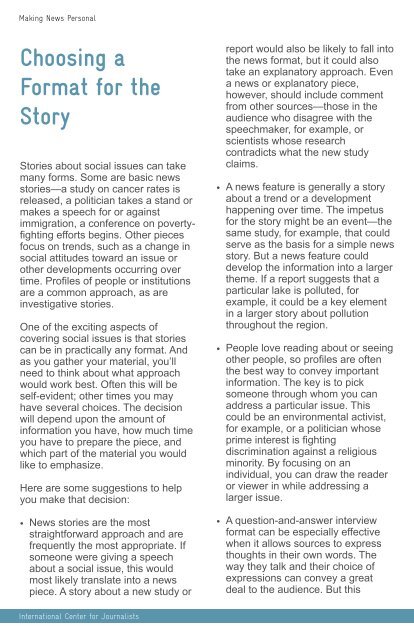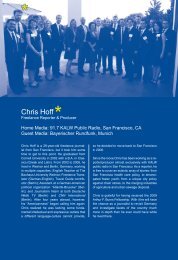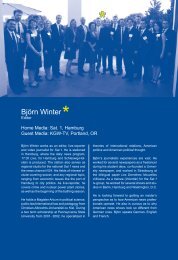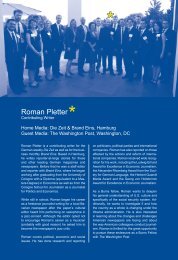Download PDF - International Center for Journalists
Download PDF - International Center for Journalists
Download PDF - International Center for Journalists
Create successful ePaper yourself
Turn your PDF publications into a flip-book with our unique Google optimized e-Paper software.
Making News Personal<br />
Choosing a<br />
Format <strong>for</strong> the<br />
Story<br />
Stories about social issues can take<br />
many <strong>for</strong>ms. Some are basic news<br />
stories—a study on cancer rates is<br />
released, a politician takes a stand or<br />
makes a speech <strong>for</strong> or against<br />
immigration, a conference on povertyfighting<br />
ef<strong>for</strong>ts begins. Other pieces<br />
focus on trends, such as a change in<br />
social attitudes toward an issue or<br />
other developments occurring over<br />
time. Profiles of people or institutions<br />
are a common approach, as are<br />
investigative stories.<br />
One of the exciting aspects of<br />
covering social issues is that stories<br />
can be in practically any <strong>for</strong>mat. And<br />
as you gather your material, you’ll<br />
need to think about what approach<br />
would work best. Often this will be<br />
self-evident; other times you may<br />
have several choices. The decision<br />
will depend upon the amount of<br />
in<strong>for</strong>mation you have, how much time<br />
you have to prepare the piece, and<br />
which part of the material you would<br />
like to emphasize.<br />
Here are some suggestions to help<br />
you make that decision:<br />
• News stories are the most<br />
straight<strong>for</strong>ward approach and are<br />
frequently the most appropriate. If<br />
someone were giving a speech<br />
about a social issue, this would<br />
most likely translate into a news<br />
piece. A story about a new study or<br />
report would also be likely to fall into<br />
the news <strong>for</strong>mat, but it could also<br />
take an explanatory approach. Even<br />
a news or explanatory piece,<br />
however, should include comment<br />
from other sources—those in the<br />
audience who disagree with the<br />
speechmaker, <strong>for</strong> example, or<br />
scientists whose research<br />
contradicts what the new study<br />
claims.<br />
• A news feature is generally a story<br />
about a trend or a development<br />
happening over time. The impetus<br />
<strong>for</strong> the story might be an event—the<br />
same study, <strong>for</strong> example, that could<br />
serve as the basis <strong>for</strong> a simple news<br />
story. But a news feature could<br />
develop the in<strong>for</strong>mation into a larger<br />
theme. If a report suggests that a<br />
particular lake is polluted, <strong>for</strong><br />
example, it could be a key element<br />
in a larger story about pollution<br />
throughout the region.<br />
• People love reading about or seeing<br />
other people, so profiles are often<br />
the best way to convey important<br />
in<strong>for</strong>mation. The key is to pick<br />
someone through whom you can<br />
address a particular issue. This<br />
could be an environmental activist,<br />
<strong>for</strong> example, or a politician whose<br />
prime interest is fighting<br />
discrimination against a religious<br />
minority. By focusing on an<br />
individual, you can draw the reader<br />
or viewer in while addressing a<br />
larger issue.<br />
• A question-and-answer interview<br />
<strong>for</strong>mat can be especially effective<br />
when it allows sources to express<br />
thoughts in their own words. The<br />
way they talk and their choice of<br />
expressions can convey a great<br />
deal to the audience. But this<br />
<strong>International</strong> <strong>Center</strong> <strong>for</strong> <strong>Journalists</strong>
















